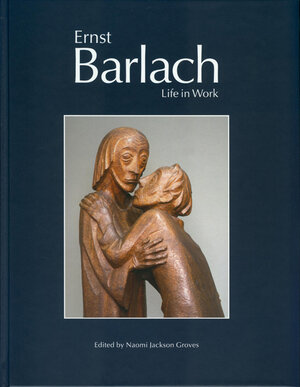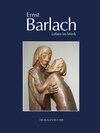Ernst Barlach - Life in Work
Sculpture, Drawings and Graphics, Dramas, Prose Works and Letters in Translation
herausgegeben von Naomi Jackson Groves, aus dem Deutschen übersetzt von Naomi Jackson GrovesWell known internationally as a sculptor, the North German artist Ernst Barlach (1870-1938) is revealed in the present volume as an outstanding writer as well, being accepted already as such in German literary circles. Barlach’s writings – early stories, later dramas and novels, diaries and letters – are presented alongside his drawings, woodcuts and lithographs, his first clay working models alongside the later completed sculpture in wood, bronze, or other medium. No other single book on the multi-gifted artist reveals as fully and objectively the creative unity of spirit behind the interplay of his many forms of expression. The presentation is in chronological order and thematic context, sometimes with cross-references in the captions, to clarify the complex connections. The formative years of this artist with the ‘thinking eye’ are stressed just as fully as is the period of his maturity. With few exceptions, all major works are included – most writings perforce in excerpt; several of these appear here for the first time in book form. Discreet guidance is given in brief commentaries; the Introduction interweaves the artist’s life and work. A short chronology of dates is appended, along with a list of works for English readers. Constant good contact has been maintained with Barlach research centres in Güstrow, Hamburg, and Ratzeburg, as well as with the publishing house of R. Piper & Co. in Munich. The entire translation, as well as the original selection, is by the editing author.
Barlach emerged by 1911/1912 as a highly regarded sculptor in wood and despite his penchant for solitary off-sidedness enjoyed deep respect among the German Expressionists who belonged to a generation younger than his own. By 1930 seven of his plays had been given stage production, usually under outstanding directors. After the Second World War, public interest in his sculpture and graphic work was roused by notable exhibitions and by the establishment in West and East Germany of at least four permanent centres for his work. Critical German editions of his dramas and prose works, two large volumes of his letters, and three imposing volumes of his oeuvre in visual media show the astounding breadth of his creative production. Outside Germany as well, Barlach research flourishes vigorously.
Naomi Jackson Groves [born in Montreal 27.7.1910, died in Ottawa 26.12.2001] visited Germany in 1936/1937 on a travelling fellowship from the Canadian Federation of University Women, in order to explore cases of creative versatility. She discovered her first Barlachs, painfully difficult of access, in the years when the artist, branded by the Nazis as a “culture Bolshevik” and not allowed to show his works, endured his final misery in his Heidberg studio outside the town of Güstrow in Mecklenburg. No personal meeting took place, but from that time forth the author of this book has held true to the artist she considers the greatest of the “multi-gifted” of his century. Shortly after World War II she obtained the Ph. D. at Harvard University, with a thesis read by Professors Karl Vietor and Jakob Rosenberg – Germanics and Art History in unison academically rare but vital for Ernst Barlach’s work. The voluminous thesis, still the only combined appraisal of Barlach’s work in all media, is titled: “Ernst Barlach – The Development of a Versatile Genius”. Since the 1940s Mrs. Groves has been actively engaged in both Germanics and Art History, translating Barlach works into English, establishing contact with his friends and collectors in Europe and North America, and happily helping in the United States and Canada to arrange exhibitions of his works and performances in English of his plays. She has made herself useful in the preparation of the Work Catalogues compiled by the late Friedrich Schult in Güstrow, and has served for years as a Board Member of the Ernst Barlach Society (headquarters in Hamburg). From 1951 to 1958 she was in charge of Fine Arts at McMaster University in Hamilton, Ontario, which in May 1972 granted her an honorary Doctor of Letters, in large part for her efforts in the field of Barlach research.
Barlach emerged by 1911/1912 as a highly regarded sculptor in wood and despite his penchant for solitary off-sidedness enjoyed deep respect among the German Expressionists who belonged to a generation younger than his own. By 1930 seven of his plays had been given stage production, usually under outstanding directors. After the Second World War, public interest in his sculpture and graphic work was roused by notable exhibitions and by the establishment in West and East Germany of at least four permanent centres for his work. Critical German editions of his dramas and prose works, two large volumes of his letters, and three imposing volumes of his oeuvre in visual media show the astounding breadth of his creative production. Outside Germany as well, Barlach research flourishes vigorously.
Naomi Jackson Groves [born in Montreal 27.7.1910, died in Ottawa 26.12.2001] visited Germany in 1936/1937 on a travelling fellowship from the Canadian Federation of University Women, in order to explore cases of creative versatility. She discovered her first Barlachs, painfully difficult of access, in the years when the artist, branded by the Nazis as a “culture Bolshevik” and not allowed to show his works, endured his final misery in his Heidberg studio outside the town of Güstrow in Mecklenburg. No personal meeting took place, but from that time forth the author of this book has held true to the artist she considers the greatest of the “multi-gifted” of his century. Shortly after World War II she obtained the Ph. D. at Harvard University, with a thesis read by Professors Karl Vietor and Jakob Rosenberg – Germanics and Art History in unison academically rare but vital for Ernst Barlach’s work. The voluminous thesis, still the only combined appraisal of Barlach’s work in all media, is titled: “Ernst Barlach – The Development of a Versatile Genius”. Since the 1940s Mrs. Groves has been actively engaged in both Germanics and Art History, translating Barlach works into English, establishing contact with his friends and collectors in Europe and North America, and happily helping in the United States and Canada to arrange exhibitions of his works and performances in English of his plays. She has made herself useful in the preparation of the Work Catalogues compiled by the late Friedrich Schult in Güstrow, and has served for years as a Board Member of the Ernst Barlach Society (headquarters in Hamburg). From 1951 to 1958 she was in charge of Fine Arts at McMaster University in Hamilton, Ontario, which in May 1972 granted her an honorary Doctor of Letters, in large part for her efforts in the field of Barlach research.












